
Doom is a first-person shooter game developed and published by id Software. Released on December 10, 1993, for DOS, it is the first installment in the Doom franchise. The player assumes the role of a space marine, later unofficially referred to as Doomguy, fighting through hordes of undead humans and invading demons. The game begins on the moons of Mars and finishes in hell, with the player traversing each level to find its exit or defeat its final boss. It is an early example of 3D graphics in video games, and has enemies and objects as 2D images, a technique sometimes referred to as 2.5D graphics.

Heretic is a dark fantasy first-person shooter video game released in December 1994. It was developed by Raven Software and published by id Software through GT Interactive.

Hexen: Beyond Heretic is a fantasy first-person shooter video game developed by Raven Software and published by id Software distributed through GT Interactive on October 30, 1995. It is the indirect sequel to 1994's Heretic, and the second game in Raven Software's "Serpent Riders" trilogy, which culminated with Hexen II. The title comes from the German noun Hexen, which means "witches", and/or the verb hexen, which means "to cast a spell". Game producer John Romero stated that a third, unreleased game in this series was to be called Hecatomb.

id Software LLC is an American video game developer based in Richardson, Texas. It was founded on February 1, 1991, by four members of the computer company Softdisk: programmers John Carmack and John Romero, game designer Tom Hall, and artist Adrian Carmack.

Rise of the Triad: Dark War is a first-person shooter video game, developed and published by Apogee Software in 1995. The player can choose one of five different characters to play as, each bearing unique attributes such as height, speed, and endurance. The game's story follows these five characters who have been sent to investigate a deadly cult, and soon become aware of a deadly plot to destroy a nearby city. Its remake was designed by Interceptor Entertainment and released by Apogee Games in 2013. The shareware version of the game is titled Rise of the Triad: The HUNT Begins.
Commander Keen is a series of side-scrolling platform video games developed primarily by id Software. The series consists of six main episodes, a "lost" episode, and a final game; all but the final game were released for MS-DOS in 1990 and 1991, while the 2001 Commander Keen was released for the Game Boy Color. The series follows the eponymous Commander Keen, the secret identity of the eight-year-old genius Billy Blaze, as he defends the Earth and the galaxy from alien threats with his homemade spaceship, rayguns, and pogo stick. The first three episodes were developed by Ideas from the Deep, the precursor to id, and published by Apogee Software as the shareware title Commander Keen in Invasion of the Vorticons; the "lost" episode 3.5 Commander Keen in Keen Dreams was developed by id and published as a retail title by Softdisk; episodes four and five were released by Apogee as the shareware Commander Keen in Goodbye, Galaxy; and the simultaneously developed episode six was published in retail by FormGen as Commander Keen in Aliens Ate My Babysitter. Ten years later, an homage and sequel to the series was developed by David A. Palmer Productions and published by Activision as Commander Keen. Another game was announced in 2019 as under development by ZeniMax Online Studios, but was not released.

Descent is a first-person shooter (FPS) game developed by Parallax Software and released by Interplay Productions in 1995 for MS-DOS, and later for Macintosh, PlayStation, and RISC OS. It popularized a subgenre of FPS games employing six degrees of freedom and was the first FPS to feature entirely true-3D graphics. The player is cast as a mercenary hired to eliminate the threat of a mysterious extraterrestrial computer virus infecting off-world mining robots. In a series of mines throughout the Solar System, the protagonist pilots a spaceship and must locate and destroy the mine's power reactor and escape before being caught in the mine's self-destruction, defeating opposing robots along the way. Players can play online and compete in either deathmatches or cooperate to take on the robots.

Alfonso John Romero is an American director, designer, programmer and developer in the video game industry. He is a co-founder of id Software and designed their early games, including Wolfenstein 3D (1992), Doom (1993), Doom II (1994), Hexen (1995) and Quake (1996). His designs and development tools, along with programming techniques developed by id Software's lead programmer, John Carmack, popularized the first-person shooter (FPS) genre. Romero is also credited with coining the multiplayer term "deathmatch".

Doom II, also known as Doom II: Hell on Earth, is a first-person shooter game in the Doom franchise developed by id Software. It was released for MS-DOS in 1994 and Macintosh in 1995. Unlike the original Doom, which was initially only available through shareware and mail order, Doom II was sold in stores.
id Tech 1, also known as the Doom engine, is the game engine used in the id Software video games Doom and Doom II: Hell on Earth. It is also used in Heretic, Hexen: Beyond Heretic, Strife: Quest for the Sigil, Hacx: Twitch 'n Kill, Freedoom, and other games produced by licensees. It was created by John Carmack, with auxiliary functions written by Mike Abrash, John Romero, Dave Taylor, and Paul Radek. Originally developed on NeXT computers, it was ported to MS-DOS and compatible operating systems for Doom's initial release and was later ported to several game consoles and operating systems.
Doom WAD is the default format of package files for the video game Doom and its sequel Doom II: Hell on Earth, that contain sprites, levels, and game data. WAD stands for Where's All the Data? Immediately after its release in 1993, Doom attracted a sizeable following of players who created their own mods for WAD files—packages containing new levels or graphics—and played a vital part in spawning the mod-making culture which is now commonplace for first-person shooter games. Thousands of WADs have been created for Doom, ranging from single custom levels to full original games; most of these can be freely downloaded over the Internet. Several WADs have also been released commercially, and for some people the WAD-making hobby became a gateway to a professional career as a level designer.

Chex Quest is a non-violent first-person shooter video game created in 1996 by Digital Café, originally intended as a Chex cereal promotion aimed at children aged 6–9 and up. It is a total conversion of the more explicitly violent video game Doom. Chex Quest won both the Golden EFFIE Award for Advertising Effectiveness in 1996 and the Golden Reggie Award for Promotional Achievement in 1998, and it is known today for having been the first video game ever to be included in cereal boxes as a prize. The game's cult following has been described by the press as being composed of unusually devoted fans of an advertising vehicle from a bygone age.

Rogue Entertainment was an American computer game developer based in Dallas, Texas, which was active in the late 1990s. It was founded by Rich Fleider, Steve Maines, and Jim Molinets in 1994. Rogue Entertainment's office was in the same building as id Software, all of their games used game engines created by id Software, and two of their games were expansions for id Software's Quake series of games. The company's first game, Strife: Quest for the Sigil, was released as shareware on February 23, 1996, with the retail version later being released on May 31, 1996. Many former Rogue Entertainment employees moved to Nerve Software after Rogue Entertainment shut down.

PowerSlave, known as Exhumed in Europe and 1999 AD: Resurrection of the Pharaoh in Japan, is a first-person shooter video game developed by Lobotomy Software and published by Playmates Interactive Entertainment in North America, and BMG Interactive in Europe and Japan. It was released in North America, Europe and Japan, for the Sega Saturn, PlayStation, and MS-DOS over the course of a year from late 1996 to late 1997. On May 24, 2015, Powerslave EX, an unofficial remake of the PlayStation version appeared on GitHub. The MS-DOS version of PowerSlave was added to the GOG store on November 19, 2020.

Doom RPG is a mobile phone game developed by Fountainhead Entertainment and published by JAMDAT Mobile. It combines the Doom first-person shooter franchise with role-playing video game elements. The storyline incorporates many similar events of Doom 3, but involves different characters than those in the third game.
Mountain King Studios is a computer game company located in Chicago, Illinois. It was founded by game programmer/game designer Scott Host. In addition to the development of Raptor: Call of the Shadows, Cygnus also collaborated with Apogee Software on a number of their games. Some members of the company split to form Rogue Entertainment, while the company itself was renamed "Mountain King Studios".

Doom is an American media franchise created by John Carmack, John Romero, Adrian Carmack, Kevin Cloud, and Tom Hall. The series usually focuses on the exploits of an unnamed space marine operating under the auspices of the Union Aerospace Corporation (UAC), who fights hordes of demons and the undead to save Earth from an apocalyptic invasion.

A first-person shooter (FPS) is a video game centered on gun fighting and other weapon-based combat seen from a first-person perspective, with the player experiencing the action directly through the eyes of the main character. This genre shares multiple common traits with other shooter games, and in turn falls under the action games category. Since the genre's inception, advanced 3D and pseudo-3D graphics have proven fundamental to allow a reasonable level of immersion in the game world, and this type of game helped pushing technology progressively further, challenging hardware developers worldwide to introduce numerous innovations in the field of graphics processing units. Multiplayer gaming has been an integral part of the experience, and became even more prominent with the diffusion of internet connectivity in recent years.
Wrack is a single-player, cel shaded first-person shooter video game developed and published by Final Boss Entertainment for Microsoft Windows. The full release of the game was on September 30, 2014. The game was mostly inspired by games such as Doom and Mega Man.















